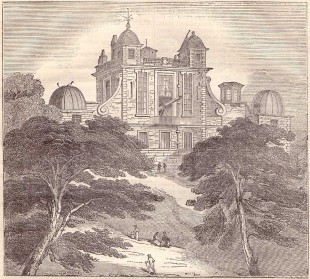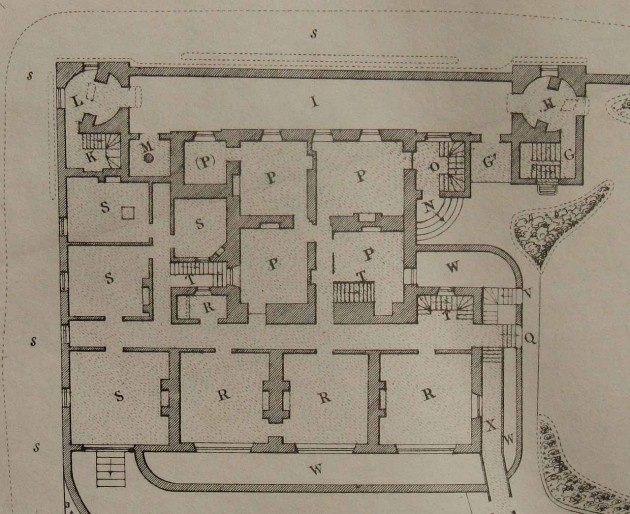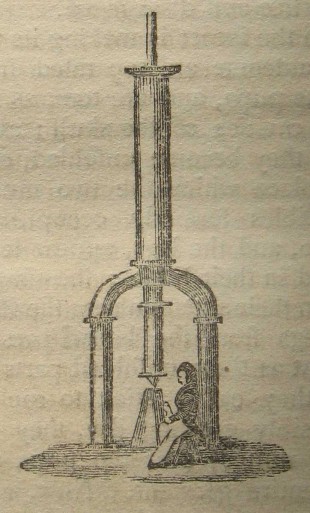…where east meets west
- Home
- Brief History
- The Greenwich Meridian
- Greenwich
(1675–1958) - Herstmonceux
(1948–1990) - Cambridge
(1990–1998) - Outstations (1822–1971)…
- – Chingford (1822–1924)
- – Deal
(1864–1927) - – Abinger
(1923–1957) - – Bristol & Bradford on Avon
(1939–1948) - – Bath
(1939–1949) - – Hartland
(1955–1967) - – Cape of Good Hope
(1959–1971)
- Administration…
- – Funding
- – Governance
- – Inventories
- – Pay
- – Regulations
- – Royal Warrants
- Contemporary Accounts
- People
- Publications
- Science
- Technology
- Telescopes
- Chronometers
- Clocks & Time
- Board of Longitude
- Libraries & Archives
- Visit
- Search
Telescope: Pond’s 25-foot Great Zenith Tube (1833)
Ordered by John Pond from Edward Troughton in 1820, the Great Zenith Tube was eventually erected in June 1833. In the published observations, Pond also refers to it as a Zenith Micrometer. It had an object-glass (OG) by Dollond. Regular observations began in August 1833 with those for 1833 & 1834 being published in Greenwich Observations. No further observations were published until 1837 following several modifications to both the instrument and the room in which it was housed. Never a success, the Zenith Tube was replaced in 1851 with a Reflex Zenith Tube of Airy’s own design. Dismounted in May 1848, it was divided (at its joints) into several parts and preserved in the Octagon Room in frames specially constructed to hold them. Its OG was removed by Airy in 1850 and used in the construction of a collimator for his Altazimuth Instrument. According to Howse, the instrument was partially destroyed by a shell splinter in WW2. The surviving parts are in the care of the National Maritime Museum.The 1840 inventory (RGO39/1records that at that date the clock Arnold 2 was also in the room, having been previously been in the adjoining room (the West Dome, which started life as the western summerhouse). The introductions to the various volumes of Greenwich Observations would imply that it was moved there by Airy that year.
Description of the telescope
The following details are taken from the Introduction to the 1837 volume of Greenwich Observations.
‘The focal length of the vertical telescope is about 25 feet, and its aperture 5 inches. It turns horizontally [freely in azimuth] upon a conical pivot at its lower end, and in a collar with steadying springs at nearly 5 feet from its upper end. This collar is carried by the upper extremity of a very large iron tube, within which the tube of the telescope revolves without touching it: the iron tube is supported by four curved iron legs diverging from its lower extremity, which is 4 feet 8 inches above the lower extremity of the telescope: the iron tube has no other support; and neither the iron tube nor its legs is connected with the walls of the building. At 3½ inches below the object glass, the wire of the plumb-line is attached to a reel exterior to the telescope-tube (carried by the tube), and, passing over a screw, depends in the interior of the tube. The use of the screw is, to enable the observer to move the point of suspension laterally, either for the convenience of bringing the wire to the center of the field of the microscopes, or for the estimation of the relative values of the micrometers (to be mentioned hereafter). The wire in the greater part of its length passes within a small tube fixed within the telescope-tube: the plumb-bob hangs in a pot of water attached below the plate closing the lower end of the telescope-tube. At 5½ inches below the screw, a micrometer-microscope is fixed on the same side of the tube, for observing the upper part of the wire: at the opposite side of the tube is an aperture with a reflector, for illuminating the microscope. At 1½ inches above the lower end of the telescope, another micrometer-microscope is fixed on the opposite side of the tube, for observing the lower part of the wire. In the eye-piece of the telescope there are, carried by a fixed plate, ten pairs of wires arranged as acute crosses; and, carried by the moveable micrometer-plate, eleven single wires, whose intervals are not very different from those of the fixed crosses. This moveable plate is made to slide by a micrometer-screw acting in opposition to a spring in the usual way: its range is such as will carry any one of the moveable wires to touch the adjacent fixed wires on each side. The eye-piece is a four-glass eye-piece with a diagonal reflector: it is carried by a separate slider.
In the daily use of the Zenith Tube, it is reversed in azimuth after each observation.’
Later volumes of Greenwich Observations carried a slightly extended version as a result of changes subsequently made to the instrument. Click here to read the final version to be published before the instrument was decommissioned.
The Zenith Tube Room

Greenwich Observatory. The top of the room created by Pond for the Great Zenith Tube is visible above the tree on the right. From the 12 December 1833 edition of The Mirror of Literature, Amusement and Instruction
The extension of Flamsteed House for Airy in 1835 had a negative effect on the seeing particlulaly as a result of a stove installed in the most northerly of the new bedrooms whose flue failed to clear the top of the Octagon Room. With the prevailing wind from the southwest, the smoke must frequently have blown across the top of the Zenith Tube, and towards the Octagon Room windows. Airy told the Visitors in 1836 that he had ‘reason to think that much of the difficulty of seeing stars well defined, &c. arose from the passage of currents of unequally-heated air near to the object-glass’. It took some time for the flue to be rerouted. The Zenith Tube Room was incorporated into the living accommodation in 1848. The1846 plans deposited in the National Archives (ADM140/426) include an east-west sectional view though the Zenith Tube and Zenith Tube Room (Section 6).

Ground floor plan of Flamsteed House and the former summerhouses in 1847. The Zenith Tube Room is marked (M). The rooms built as part of Airy's 1835 extension are marked (S). Detail from a plan published as an addendum to the 1845 volume of Greenwich Observations
Published Observations
1833 Observations*
1834 Observations**
* Made by John Pond, (P.) John Belville (H.), William Rogerson (W.R.) and Frederick Simms (F.S.)
** Made by William Richardson (R.), William Rogerson (W.R.), John Belville (H.) and Frederick Simms (F.S.)
No observations were published in 1835 & 1836
1837 Observations
1838 Observations
1839 Observations
1840 Observations
1841 Observations
1842 Observations
1843 Observations
1844 Observations
1845 Observations
1846 Observations
1847 & 1848 Observations
Pond’s papers on methods of using the telescope
Some suggestions relative to the best method of employing the new zenith telescope lately erected at the Royal Observatory (Phil. Trans. R. Soc.124, pp.209–212 (1834)
Continuation of a former paper on the twenty-five feet zenith telescope lately erected at the Royal Observatory (Phil. Trans. R. Soc.125, pp.145–151 (1834))
Published discussions of the observations
Main, R.: On the Values of the Constants of Nutation and Aberration, and of the Parallax of γ Draconis, as deduced from the Observations made with the Twenty-five-foot Zenith Tube at the Royal Observatory, Greenwich (Memoirs of the Royal Astronomical Society, Vol. 24, p.147–187
© 2014 – 2025 Graham Dolan
Except where indicated, all text and images are the copyright of Graham Dolan
